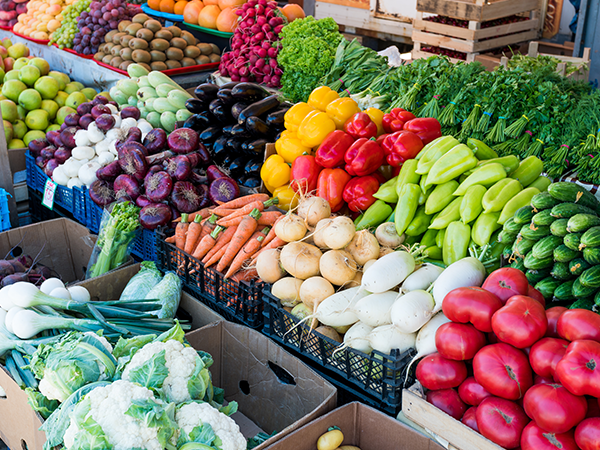Investing in food security

Walking around the supermarket in a developed economy, even with global supply chains disrupted due to the ongoing Covid pandemic, you’d be forgiven for thinking our food system is thriving. Shelves are often well stocked and there’s ample choice. However, beneath the shelves surface, it’s a different story.
The cost of food across all food groups increased between January 2021 and
January 2022
1
in the US. Cereals and bakery products had the largest increase of any food category increasing by 1.8%, whilst dairy increased by 1.1%. Produce items experienced similar price hikes, with fruits and vegetables increasing 0.9% and meat, poultry, fish and egg prices went up 0.3%.
2
Many of these price increases have been put down to ongoing Covid concerns including supply chain disruption, and are reflective of increases in production costs (especially packaging). Some economists are signalling these as temporary and transient cost increases – but are they? What do we really know about the food we eat? What impact does it have on us and our environment, and are all the costs of these impacts priced in? About 21–37% of total greenhouse gas (GHG) emissions are attributable to our food system.
3
In the face of the growing
Climate crisis
An eroding food ecosystem
What food is grown and how it’s grown is contributing to environmental imbalances that are eroding the stability of our food ecosystem. Every minute, we lose 23 hectares of arable land worldwide to drought and desertification. 4 Top soil and soil health is in chronic decline. Some scientists estimate it takes between 500-1000 years to form just 1 inch of topsoil. Since 1900, the UN Food and Agriculture Organisation (FAO) estimates 75% of the genetic plant diversity in agriculture has been lost. 5 In Thailand, for example, from 16,000 different rice varieties, just 37 remain. 6 In the pursuit of efficiency, convenience and price, agricultural diversity has been significantly reduced and agricultural policies monoculturally informed. To drive crop , synthetic fertiliser and pesticide use has increased exponentially. In 1965, the consumption of nitrogen fertilisers was 46.3 million metric tons. By 2019, this amount increased to over 190 million tons. 7 In 2019 the global consumption of agricultural pesticides was 4.19 million metric tons up from 2.3 million tons in 1990. 8
There are two significant issues with synthetic fertiliser and pesticide. First, the production and use of synthetic nitrogen fertiliser accounts for 2.4% of global
Greenhouse gas
Food consumption inequality
According to the UN, over 1.3 billion tonnes of food goes to waste every year. 13 This is against a backdrop of between 720 and 811 million people in the world facing hunger in 2020. 14 From 2019 to 2020, the number of undernourished people grew by 161 million, a crisis driven largely by conflict, climate change, and Covid-19. 15 Worldwide, obesity has nearly tripled since 1975. In 2016, more than 1.9 billion adults, 18 years and older, were overweight. 39 million children under the age of 5 were overweight or obese in 2020. 16 Conversely, in 2020, over 149 million under-fives were estimated to have been stunted, or too short for their age and more than 45 million children were wasted, or too thin for their height, 17 both as a result of chronic malnutrition and hunger. The intersect between what we eat and health (of both people and planet) are intrinsically linked. When these relationships are broken our food system’s integrity and security erodes.
The rise of regenerative farming
Regenerative and organic farming, reflecting both ecosystem health and shifting consumer sentiment, shows what’s possible when we work with nature. Since 2019, business interest in regenerative agriculture has increased 138% 18 with several big food businesses committing to regenerative agriculture in their supply chains. The global organic farming market is expected to grow from $95.38 billion in 2020 to $103.36 billion in 2021 at a compound annual growth rate (CAGR) of 8.4% and to $151.35bn in 2025 at a CAGR of 10%. 19 It’s cited that if every US farmer switched to organic farming, nearly 500 million pounds of residual and toxic pesticides could be prevented annually from entering the atmosphere and our ecosystems. 20
Despite noticeable increases in both interest and execution, and environmental benefits, organic farming is still marginalised with critics citing crop yield differences as one of the major arguments against a shift. However, there are links between modern agriculture and the climate crisis, both in terms of contribution (agriculture currently generates circa
19–29% of total greenhouse gas (GHG) emissions)
21
and risk. According to the National Aeronautics and Space Administration (NASA), maize crop yields are projected to decline by 24%, whilst wheat could potentially see growth of about 17% by 2030 under a high
Greenhouse gas
Investment opportunities in organic and regenerative agriculture are compelling. It provides a range of opportunities from investing in regenerative and organic farming directly, investing in businesses that sell regenerative and organic food, to the use of technology in agriculture (AgTech).
Another area of focus is water stress. 72% of all water withdrawals globally are used by agriculture 24 with 3.2 billion people living in agricultural areas with high to very high water shortages or scarcity, and 1.2 billion people living in severely water-constrained agricultural areas. 25 How much water we use, and where we use it are becoming critical factors in our decision making. Advances in AgTech mean there are more opportunities for precision application in agriculture – not just in watering but also in pest management. AgTech provides unique investment opportunities for tackling food security issues including hydroponics (growing plants without using soil, feeding them on mineral nutrient salts dissolved in water) and vertical farming – increasingly attractive for town planners and investors looking to provide more localised food production in urban environments.
Reducing carbon through food choices
Tackling food security issues means taking a holistic approach. Studies relating to the carbon footprint of organic food point to the yield difference and requirement for more land as the main contributors of driving up the
greenhouse gas emissions
26
associated with organic food production. However, organically farmed soils store up to
44% more carbon
27
and support 50% more wildlife.
28
Whilst debate continues as to the best way to farm, it’s clear that to tackle these issues our relationship with food needs to be reimagined including what we eat and how much of it. In the developed world we’ve become used to having whatever we want, whenever we want. We can afford much so we buy much – which is one of the main drivers of food waste globally,
contributing to between 8-10% of total human made greenhouse gas emissions
29
with a
Concentration
Investing in food
There are opportunities in
Microfinance
Intergovernmental Panel on Climate Change (IPCC)
Direct investment
- investments in scaling up climate resilience across food systems (e.g. water distribution and flood defences);
- strengthening the resilience of the most vulnerable to economic adversity (e.g. investments in microfinance and job creation);
- calling for and supporting developments in accounting to ensure the true cost of food production is reflected on balance sheets. These serve to intervene along the food supply chains to lower the cost of nutritious foods; and
- tackling poverty and structural inequalities, ensuring interventions are inclusive and support those living in poverty (e.g. access to clean and affordable energy).
The intersectionality between the environment, food, and human health provides investors with a range of investment opportunities to help transition our food system to future fitness. Capital needs to be allocated to these opportunities to halt the looming crisis in our food system and increase its security. Our new food system needs to be based on the principles of post industrialisation and be anchored in more localised, equitable, health oriented and nature sensitive policies and practices.
Footnotes
- Scroll to footnote
- Scroll to footnote
- Scroll to footnote
- Scroll to footnote
- Scroll to footnote
- Scroll to footnote
- Scroll to footnote
- Scroll to footnote
- Scroll to footnote
- Scroll to footnote
- Scroll to footnote
- Scroll to footnote
- Scroll to footnote
- Scroll to footnote
- Scroll to footnote
- Scroll to footnote
- Scroll to footnote
- Scroll to footnote
- Scroll to footnote
- Scroll to footnote
- Scroll to footnote
- Scroll to footnote
- Scroll to footnote
- Scroll to footnote
- Scroll to footnote
- Scroll to footnote
- Scroll to footnote
- Scroll to footnote
- Scroll to footnote
- Scroll to footnote
- Scroll to footnote
- Scroll to footnote




